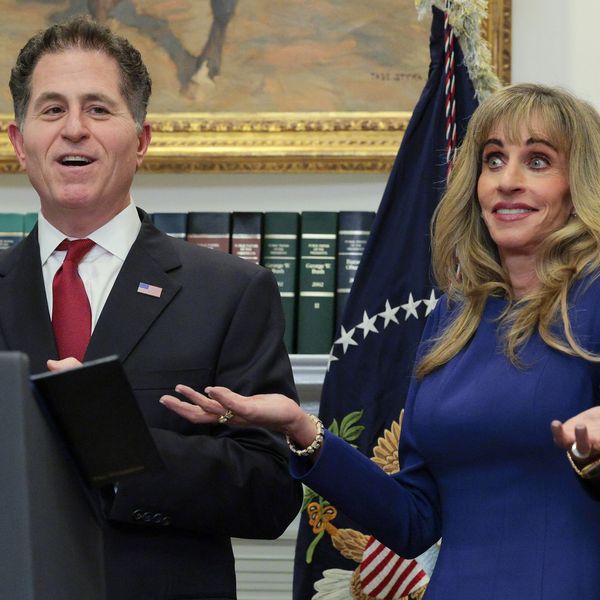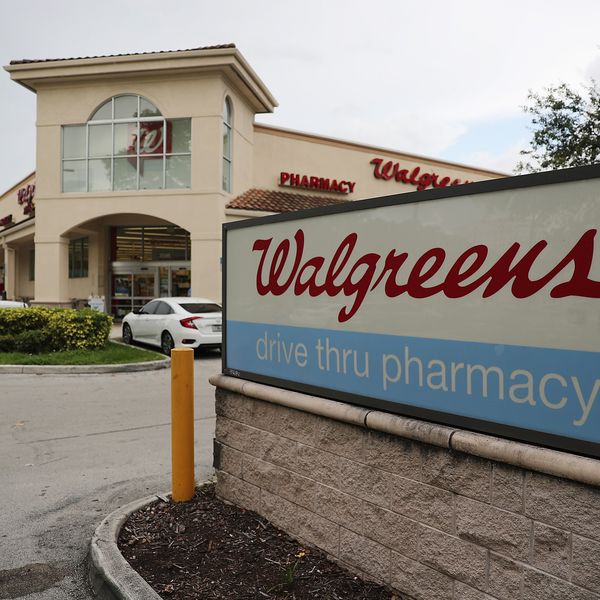If you were driving by a remote stretch of Minnesota County Highway 210—connecting Wahpeton, North Dakota and Fergus Falls—you would see a massive billboard depicting a painting of three goats. It looks out of place—colorful and vibrant on a desolate stretch of highway mostly used by westbound truckers and locals. On the top left-hand corner of the billboard rests a stark reminder to anyone looking up: "In rural we tend to the herd."
My wife and I share a farm with Edith, Willa, and Milagro—our three goats and the willing subjects of the billboard—and 10 laying chickens, two inside dogs, and three outside cats. As a recipient of Minnesota's three-year-old Guaranteed Income for Artists pilot program, I was inspired to create the billboard as a tribute to the state's guaranteed income pilot, which tends to the community and is changing the lives of artists like myself.
Since moving to Otter Tail County in 2017, I've deepened my connection to the land and the rhythms of rural life. I am attuned to the changing of the seasons, and the serene landscape outside my windows becomes inspiration for paintings in my home studio. Living in a rural setting provides the space I need to get into the creative flow. And the quiet, slower pace of life has unlocked the creative freedom to make my large-scale narrative paintings.
As policymakers and community leaders consider implementing guaranteed income programs, I hope they look to Minnesota's example.
But making a living as an artist in rural Minnesota is no easy feat. It often requires having many different income streams to stay on top of student loans, car payments, and grocery bills. So, when I received an email telling me I had been chosen by lottery to participate in a new pilot providing guaranteed income for rural artists, I breathed a sigh of relief.
The program is set to expand, soon providing no-strings-attached $500 monthly payments to 100 artists for five years—far exceeding typical 12-18-month pilots. This growth cements its position as the nation's longest-running guaranteed income pilot focusing on both urban and rural creators. For me and my fellow artists, this small yet mighty payment has unlocked creative freedom and opened new opportunities that ripple through our communities.
As Minnesota finds itself in the national spotlight following Gov. Tim Walz's candidacy for Vice President, our state's innovative approaches to social and economic policy are garnering renewed attention. As of 2024, 10 states have introduced legislation attempting to ban guaranteed income programs. The misplaced fear stems from ideological and economic concerns about the effects of guaranteed income even though more than a dozen studies have shown that it leads to higher employment rates, housing and food security, and more family time.
When artists have the freedom to create and engage, we become catalysts for positive change that benefits entire communities. Take Jess Torgerson, a multidisciplinary artist and community organizer in Fergus Falls, Minnesota. Before the guaranteed income program, Jess was working 60 hours a week. Now, she has partnered with another artist to create sculptures from found materials, simultaneously making art and ridding her community of unwanted waste. Then there's Torri Hanna, a fiber artist. The program helped Torri and her daughter improve their living situation and stabilize her yarn store business. Torri, too, has expanded her community involvement, working with the local senior center to create art for downtown storefront windows.
Recent data from the program shows its remarkable impacts. Participants reported a decrease in financial stress, an increase in their ability to pay for basic needs, and an increase in their ability to take on creative and community projects they wouldn't have otherwise pursued. The success of Minnesota's program is part of a larger movement, with over 100 pilot programs across the United States testing the impact for different groups of people. Programs like the Works Projects Administration coming out of the New Deal made it possible for artists to make a living and beautified our nation's infrastructure. We have a history to look back on in guiding public investments in artists—we already know that investing in artists pays back manifold.
In my community, we understand the value of tending to the herd—and we've all taken an important lesson from Edith, Willa, and Milagro, who sit in formation with their backs to each other so that they can share body heat, and each can observe a different direction to keep an eye out for threats. Our communities are strengthened when we tend to each other with the same dedication. This, to me, is what guaranteed income does for artists. It says, "We've got your back."
As policymakers and community leaders consider implementing guaranteed income programs, I hope they look to Minnesota's example. Include artists in your pilots. Recognize the unique value they bring to your communities. Understand that by supporting artists, you're nurturing the creativity, resilience, and interconnectedness that make our communities thrive. In Minnesota, we know that the strength of the herd depends on how well we tend to each individual. We know our rural parts of the state enable our strong urban centers to thrive. As you consider the future of your own communities, look out for each other. Share your warmth. Face different directions, but always stay close and connected.



